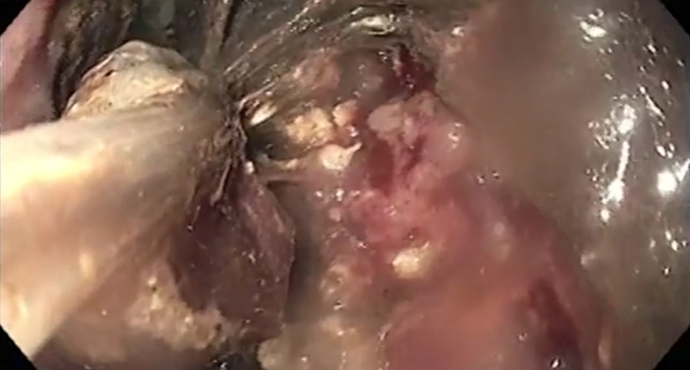Managing choledocholithiasis in patients after Roux-en-Y gastrectomy is challenging, and with no excluded stomach, endoscopic ultrasound (EUS)-guided transmural lumen-apposing metal stent placement is significantly more
Pancreas
Pancreas
Both Balloon Enteroscopy ERCP and EUS-Guided Antegrade Treatment Are Reasonable Options for Choledocholithiasis After Roux-en-Y Gastrectomy
Performance of Published Criteria in Predicting Choledocholithiasis in Practice
Choledocholithiasis can be identified through multiple means, including a right upper quadrant ultrasound, endoscopic ultrasound (EUS), endoscopic retrograde cholangiography (ERCP), magnetic resonance cholangiopancreatography (MRCP), and
Pure Cut Current for Biliary Sphincterotomy Is Associated With Less Delayed Bleeding and May Reduce Post-ERCP Pancreatitis Risk
Thermal injury from biliary sphincterotomy is thought to play a role in at least a proportion of post-ERCP pancreatitis (PEP) cases. Thus, the present study
Large Single-Use Duodenoscope Experience Shows High Success and Low Crossover Rates
Single-use duodenoscopes were developed to eliminate the risk of duodenoscope-associated transmission of infections. However, there are concerns that the performance of single-use duodenoscopes may not
Is Digital Gut-Directed Hypnotherapy Better Than Muscle Relaxation in Patients With Irritable Bowel Syndrome?
In addition to dietary modification and pharmacologic therapy, behavioral therapy has become a recognized treatment for irritable bowel syndrome (IBS) and is now integrated into
More Evidence for Early Cholecystectomy After Gallstone Pancreatitis
Same-admission cholecystectomy is recommended for patients with mild gallstone pancreatitis (GSP) to reduce recurrent GSP events and lower costs. However, adherence to same-admission cholecystectomy remains
Fluoroscopy-Free ERCP for Choledocholithiasis Is Safe and Effective in a Pilot Study
In select patients – most commonly during pregnancy – using a fluoroscopy-free approach to stone removal is preferred. Given some initial success with this approach
Lessons Learned After Post-ERCP Mortality
ERCP is a vital endoscopic procedure for the management of pancreatobiliary disease but is associated with serious adverse events, including mortality. Although a central tenet
Effectiveness of EUS Gallbladder Drainage as Primary Therapy for Malignant Biliary Obstruction
ERCP is generally the first-line approach for palliation of distal malignant biliary obstruction (DMBO), but interest in the use of endoscopic ultrasound (EUS)-guided transmural drainage
Fully Covered Self-Expanding Metal Stents Are Safe and May Be More Durable in Distal Malignant Biliary Obstruction
It is clear that metal stents are superior to plastic stents for palliation of distal malignant biliary obstruction (dMBO). Among self-expanding metal stents (SEMS), there
Primary EUS Choledochoduodenostomy Is Safe and Efficacious in Malignant Biliary Obstruction
Palliation of malignant biliary obstruction is required to facilitate oncologic therapy and relief of symptoms. Although this is almost always performed with ERCP, biliary cannulation
Consensus Guidelines Recommend Monitored Anesthesia Care for Most ERCPs
Adequate patient sedation is essential for the successful completion of ERCP; however, delivery methods of anesthesia vary between providers, with most endoscopists favoring deep sedation
Papillary Morphology Predicts Difficult Biliary Cannulation
Successful and safe ERCP requires the endoscopist to cannulate the duct of interest successfully and efficiently. Although operator skill clearly influences procedure success, there is
True Rate of Post-ERCP Pancreatitis: Do Randomized Trials Provide the Answer?
Pancreatitis after ERCP is one of the most common and morbid adverse events following any gastrointestinal endoscopy procedure. It is imperative that the consent process
Might Biliary Radiofrequency Ablation Be Less Effective Than We Thought?
Most inoperable malignant biliary strictures are best treated with self-expanding metal stents (SEMS); however, a significant portion of patients develop stent occlusion from neoplastic or
Empiric Prophylactic Plastic Stenting for Disconnected Pancreatic Duct After Necrosectomy Is Not Uniformly Beneficial
Pancreatic necrosis often results in main pancreatic duct injury and eventual discontinuity, or so-called disconnected pancreatic duct syndrome (DPDS), with recurrent symptoms from duct obstruction
ASGE Guideline on Screening for Pancreatic Cancer in High-Risk Cohorts
Pancreatic ductal adenocarcinoma (PDAC) continues to have a dismal prognosis at the time of presentation. Survival is improved with diagnosis at an early stage, but
Examining Cost-Utility Data for Interventions to Prevent Infection Transmission by Duodenoscopes
Transmission of multidrug-resistant organisms between patients undergoing ERCP prompted the U.S. Food and Drug Administration to issue guidance for endoscopy departments to adopt intensified reprocessing
Electrohydraulic Lithotripsy Safe and Effective for Clearing Obstructive Pancreatic Stones Near the Duodenum
Electrohydraulic lithotripsy (EHL) and laser lithotripsy are both well-established methods for the treatment of biliary and genitourinary stones. Several retrospective series have described successful pancreatoscopy-guided
Cholecystectomy Optimally Performed Within 8 Weeks for Necrotizing Biliary Pancreatitis
Cholecystectomy before hospital dismissal is advised for most cases of acute biliary pancreatitis (ABP). Surgery is often delayed in the setting of pancreatic necrosis to
Further Validation for a Motorized Endoscopic Necrosectomy Device
Many patients with walled-off pancreatic necrosis (WON) require debridement following minimally invasive drainage. This often entails serial procedures with cumulative expense and risk. These authors
Surveillance Rather Than Immediate Resection Appears Advisable for Most Familial Adenomatous Polyposis-Related Ampullary Adenomas
Ampullary, periampullary, and duodenal adenomas commonly occur in familial adenomatous polyposis (FAP). Their detection and management are fraught with challenges related to balancing the risk
Incision Improves Success and Safety for Difficult Biliary Access Compared With Wire- or Stent-Guided Entry
A variety of techniques have been described for achieving deep biliary cannulation, a necessary prelude to most endoscopic retrograde cholangiographic (ERCP) procedures. The rate of
On Balance, Benefit of Sphincterotomy for Biliary Stenting Appears to Outweigh the Risk
Limited reports have suggested that endoscopic biliary sphincterotomy (ES) at the time of transpapillary biliary stent placement may reduce the risk of post-ERCP pancreatitis (PEP).
Are There Signs or Symptoms That Predate the Diagnosis of Pancreatic Cancer?
Pancreatic ductal adenocarcinoma (PDAC) is the third leading cause of cancer mortality since most cancers are advanced at diagnosis. Early identification of these cancers is
DNA Methylation Studies of Biliary Brush Cytology Samples Likely to Aid in Diagnosis of Cholangiocarcinoma
Establishing a firm diagnosis for indeterminate biliary strictures is often challenging. The current standard of practice is fluoroscopic and cholangioscopic characterization with brush and biopsy
BILE Criteria to Assess ERCP Need in Cholangitis May Be More Sensitive, Less Cumbersome Than Others
Biliary obstruction with associated cholangitis usually is managed with the use of endoscopic retrograde cholangiopancreatography (ERCP) for stone extraction or stent decompression of the bile
Covered Metal Stents Equal to Multiple Plastic Stents for Treatment of Biliary Strictures From Chronic Pancreatitis but Require Fewer Procedures
Compression of the distal bile duct within a fibrotic pancreas is one complication of chronic pancreatitis (CP), which can lead to chronic cholestasis, cholangitis, and
Transpapillary Gallbladder Stent Placement Usually Successful as Destination Therapy
Severe acute cholecystitis (AC) often is palliated with percutaneous or endoscopic drainage 6 to 12 weeks prior to preplanned interval cholecystectomy. Many patients with severe
Radiofrequency Ablation Plus Stent Placement for Extrahepatic Cholangiocarcinoma Shows Benefit Over Stenting Alone
The optimal treatment for cholangiocarcinoma (CCA) or ampullary carcinoma (AC) is surgery. When deemed unresectable and not amenable to neoadjuvant therapy followed by liver transplantation,
Better, but Insufficient Results From Duodenoscope Reprocessing With Double Wash and High-Level Disinfection or Liquid Chemical Sterilization
The potential for interpatient transmission of infections by contaminated duodenoscopes is a significant concern in the practice of ERCP. Pending further understanding and development of
Cholecystectomy Before Dismissal Confirmed as Optimal in Large Population of Veterans With Biliary Pancreatitis
Multiple guidelines recommend performing cholecystectomy (CCy) before hospital dismissal for patients with mild gallstone pancreatitis that is not complicated by infection or necrosis. In this
Hydrogen Peroxide, One Way or Another, Appears Beneficial During Endoscopic Necrosectomy
Management of walled-off pancreatic necrosis often benefits from direct transmural endoscopic necrosectomy. This retrospective chart review assessed the utility of hydrogen peroxide (H2O2) lavage as
Best Conformation for Hilar Self-Expanding Metal Stents Remains Undefined
Bilateral placement of metal stents for malignant hilar strictures (MHS) can be challenging. Two approaches have been used, each with potential benefits and challenges. In
Updated Criteria for Prediction of Choledocholithiasis Add Specificity
A variety of recommendations have been proposed for predicting choledocholithiasis based upon presenting signs, symptoms, initial laboratory studies, and imaging. In this retrospective study, the
Further Evidence Supporting Early, Primary Use of Precut Sphincterotomy for Duct Access
Deep access to the bile duct or the pancreatic duct is required in order to complete all subsequent therapeutic ERCP maneuvers. Precut sphincterotomy (PCS) refers
Endoscopic Approaches to Drainage for Acute Cholecystitis Are Optimal in Nonoperative Patients
Gallbladder removal or drainage is a key component of treatment for acute cholecystitis. When the risk of urgent cholecystectomy is considered prohibitive, the optimal alternative
First Single-Use Duodenoscope Measures up in Direct Comparison for Low-Complexity Procedures
The development of single-use (disposable) endoscopes is one approach to eliminating infection transmission between sequential patients during endoscopy. This single-center study randomized patients undergoing endoscopic
Large-Caliber Dilation Without Sphincterotomy Is Efficacious and Safe for Stones >10 mm
Endoscopic biliary sphincterotomy (ES) is the standard prelude to duct stone removal; however, it carries moderate risk for both pancreatitis and bleeding and can be
Pancreatic Extracorporeal Shock Wave Lithotripsy: Efficient and Effective in Gastroenterologists’ Hands
Extracorporeal shock wave lithotripsy (ESWL) has become the dominant therapy for the treatment of symptomatic pancreatic duct stone obstruction in chronic calcific pancreatitis. In the
Video Auditing of Duodenoscope Reprocessing Contributes to High Performance in a Tertiary Care Center
Lapses in reprocessing of flexible endoscopes have been demonstrated in many environments and are thought to contribute to the transmission of infection between patients. The
Urgent Early Pancreatic Drainage Is Safe and Effective
Endoscopic decompression and drainage of immature pancreatic and peripancreatic fluid collections with incomplete encapsulation by a wall of surrounding tissue have generally been avoided out
Metal stents for pancreatic cyst drainage – equivalent success, more complications?
Endosonographic drainage of pancreatic cysts is currently regarded as the standard throughout the world, in comparison with other treatments (such as percutaneous drainage or surgery).
News from DDW
The latest developments in the field of gastroenterology and endoscopy are presented every year at Digestive Diseases Week (DDW) in Chicago — although in recent
 ERCP | Literature | Pancreas
ERCP | Literature | Pancreas
NSAIDs against post-ERCP pancreatitis – any doubts ?
The application of non-steroidal anti-inflammatory drugs (NSAIDs) such as indometacin or diclofenac to prevent post-ERCP pancreatitis (PEP) has been examined in several randomized trials throughout
Endoscopic therapy of pancreatic fluid collections caused by severe necrotic pancreatitis
Pancreatitis can cause various severe complications such as acute fluid collections with superinfected necrotic content requiring drainage and removal of necrotic debris. Here we demonstrate
Serous cystadenoma in the pancreas — still harmless?
Cystic pancreatic tumors are increasingly being detected at the asymptomatic stage, thanks to improved imaging, and “screening” imaging in particular. This often then leads to



